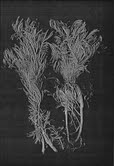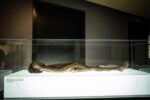Leone Contini – Inte brasse

Per sviluppare il progetto Inte brasse l’artista ha vissuto una settimana nel quartiere, esplorandone le dinamiche e tentando di stringere relazioni con le varie comunità che qui risiedono (italiani e immigrati), lavorano (transessuali) o che qui transitano per scopi precisi (spacciatori e tossicodipendenti). La diffidenza degli abitanti è non solo e non tanto indirizzata nei confronti degli estranei al Ghetto. Essa si manifesta piuttosto tra le diverse “tribù” che lo popolano.
Comunicato stampa
Il ghetto rappresenta storicamente un luogo di costrizione e isolamento all’interno della città. La stessa conformazione urbana del Ghetto genovese, caratterizzata da alcuni tra i più stretti e scuri caruggi genovesi, si presta a nascondere ed occultare. La strada principale è la famosa Via del Campo cantata da De Andrè ma girando l’angolo in uno dei vicoli laterali ecco un mondo che si distacca dal tessuto circostante: sporcizia, spazi angusti, pochi esercizi commerciali che si alternano ad attività più o meno legali.
Per sviluppare il progetto Inte brasse l’artista ha vissuto una settimana nel quartiere, esplorandone le dinamiche e tentando di stringere relazioni con le varie comunità che qui risiedono (italiani e immigrati), lavorano (transessuali) o che qui transitano per scopi precisi (spacciatori e tossicodipendenti). La diffidenza degli abitanti è non solo e non tanto indirizzata nei confronti degli estranei al Ghetto. Essa si manifesta piuttosto tra le diverse “tribù” che lo popolano.
Il titolo si ispira a un’espressione in dialetto genovese - se ciantan i spinelli inte brasse (si piantano gli spinelli nelle braccia) - che rivela sia ignoranza nei confronti del fenomeno della tossicodipendenza sia un atteggiamento di rifiuto. Il rimando alle brasse intende in questo caso, all’opposto, suggerire un atteggiamento di calorosa accoglienza. La medesima ambiguità si riscontra nell’evento che funge da perno dell’operazione, una sorta di “spaccio” - termine che rimanda alla vendita della droga, ma anche allo smercio di generi di prima necessità.
Nel Ghetto e nelle zone limitrofe le pratiche inerenti la cura del corpo radicate nella tradizione delle varie comunità di immigrati - magrebini, senegalesi ed ecuadoriani in primis - coabitano infatti con pratiche di segno opposto, legate all’abuso di droghe. Si profila quindi un ulteriore contrasto tra le comunità di migranti e la società ospite, percepita come opulenta ed autolesiva. L’artista installa dunque nella “piazza senza nome” uno spaccio in cui espone prodotti vegetali tradizionali utilizzati nelle varie culture per implementare l’energia fisica, attenuare la fame e la stanchezza, potenziare la sessualità, purificare o guarire il corpo, oltre a buoni premio
- ad esempio per un taglio di capelli dal parrucchiere marocchino. Lo spaccio di Leone Contini è organizzato secondo criteri che esulano dal commercio tradizionale, innestandosi su un tessuto di economia informale cui alcuni abitanti già danno vita ed anzi richiamandolo ulteriormente in virtù di dieci fotocopie in b/n 70X100, affisse sui muri del quartiere per un mese, che riproducono l’immagine dei vari prodotti.
La prospettiva è di allentare - laddove non sia possibile, almeno in tempi brevi, abbattere – le barriere tra le differenti comunità e tra queste e la società ospite.
Leone Contini (Firenze, 1976) è artista visuale dalla costante vocazione antropologica. La sua ricerca si colloca lungo il margine di contatto tra pratiche creative e lavoro etnografico. Metodologie e linguaggi appartenenti ad ambiti disciplinari differenti si traducono in un continuum di scrittura, video-scrittura, attività laboratoriali, relazioni. Gli ambiti dell’indagine riguardano solitamente aree di frizione caratterizzate da complessità identitaria e rapporti di potere. La sua pratica discorsiva tende a problematizzare, oltre all’oggetto sociale sottoposto ad “indagine”, anche la relazione che inevitabilmente viene a crearsi con esso. Questa tendenza a criticizzare lo
spazio della ricerca porta a mettere in discussione il concetto di autorialità e ad interrogare il posizionamento della stessa comunità artistica nei confronti del contesto in cui opera.
Progetto realizzato in collaborazione con gli abitanti del Ghetto, la casa di quartiere GhettUp e la Comunità di San Benedetto.
L’intervento di Leone Contini sarà visibile per un mese nelle vie del Ghetto.
Una postazione in cui reperire materiale sul progetto sarà allestita presso la Casa di quartiere - GhettUp.
info
CHAN Contemporary Art Association
Via Sant’Agnese 19r, 16124 Genova | M 338 5703973 – 338 1997496 | [email protected] | www.chanarte.com
Con la collaborazione di Comune di Genova
ENGLISH
Ghetto, Genova
Leone Contini
Inte brasse
---
A project by CHAN Art Association and Stefano Taccone
----
March 3rd – April 3rd 2012
Inauguration: Saturday, March 3rd @ 5 p.m, Piazza Senza Nome (“Square with no name”, NdT)/ Piazza Princesa (Vico Fregoso)
The ghetto has always been a place of constriction and isolation in town. Embedded in the darkest and narrowest Genoese streets, (the so-called caruggi), which give the area a distinctive urban shape, the Ghetto of Genova is a good place to hide and conceal. Its main street, Via del Campo, has been sung about by the worldwide-known Genoese bard Fabrizio de André, and has become very famous. But when you move just one step further from it, you will find a totally unexpected world, standing out from the surrounding areas because of its rubbish, tiny streets, and a few shops mixed up with more or less legal businesses.
In order to develop the art project “Inte brasse”, the artist has been living within this area for one week, exploring its dynamics and trying to get into close relationships with the various communities (both the Italian and immigrants), which co-exist, work (transsexuals), or pass-by here for special purposes (drug dealers and junkies). The distrust of the inhabitants is not only and necessarily addressed to the people unknown to the Ghetto, but rather to the various “tribes” combining there.
The title comes from a Genoese way of saying “se ciantan i spinelli inte brasse” (lit. they inject their arms with joints) - to highlight both ignorance and repudiation to drug addiction - the reference to “brasse” does in this case suggests, instead, an attitude of warm welcoming. The same ambiguity is to be found in the linchpin of the
whole process, a sort of “traffic”- a term related to both the drug pushing and the basic goods sale.
Within the Ghetto and its surrounding areas, the body care practices, traditionally embedded in the various immigrant communities- Maghrebi, Senegalese and especially Ecuadorians, do indeed coexist in different ways, and are linked to drug abuse, profiling a contrast between the migrant communities and their hosting society, which is then perceived as opulent and self-injurious. The artist therefore sets up in the “square with no name” a spot to show traditional vegetable products, which are used in the different cultures to enforce the physical energy, soften hunger and weariness, empower the sexuality, purify or cure the body, and, at the
same time, he will give vouchers for a moroccoan haircut, for instance. Leone Contini’s sale is organized in a non-traditionally commercial way and relies on an informal economy, that of the immigrant population and is also enphasized by posters in b/w 70x100, hanging in the district for one month, displaying the images of
the various products. The aim is to loosen, or when it’s possible to break down, the barriers between the communities and their hosting society.
Leone Contini (Florence, 1976), is a visual artist with an anthropological calling. He moves half-way between creative practices and ethnographic work. He applies methods and codes belonging to different disciplines, in order to convert it all into a continuum where writing, video-writing, lab activities and relations combine. His areas of interests usually relate to situations of contrast, marked by an identity complexity and ties of power. His conversational practice tends to problematize both the social subject to be analyzed and the relationship that is inevitably started with it. This trend in criticizing the main values of the artistic research itself leads to further enquiries upon the idea of authorship.
This project has been co-partnered by the Ghetto inhabitants, the Casa di quartiereGhettUp and the Comunità di San Benedetto.
Leone Contini’s intervention will be displayed in the Ghetto for one month.
Further info about the project will be available at Casa di quartiere- GhettUp.



